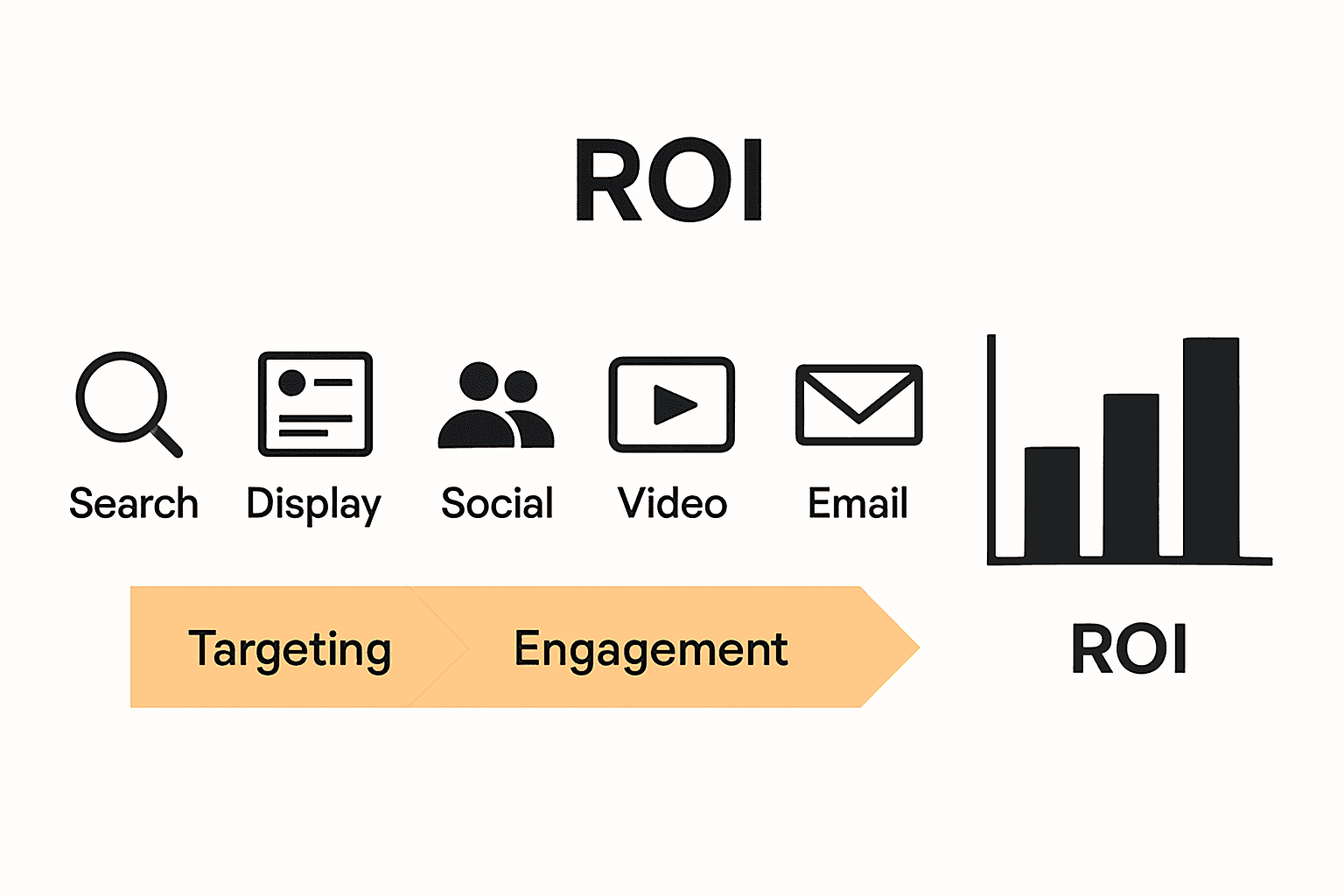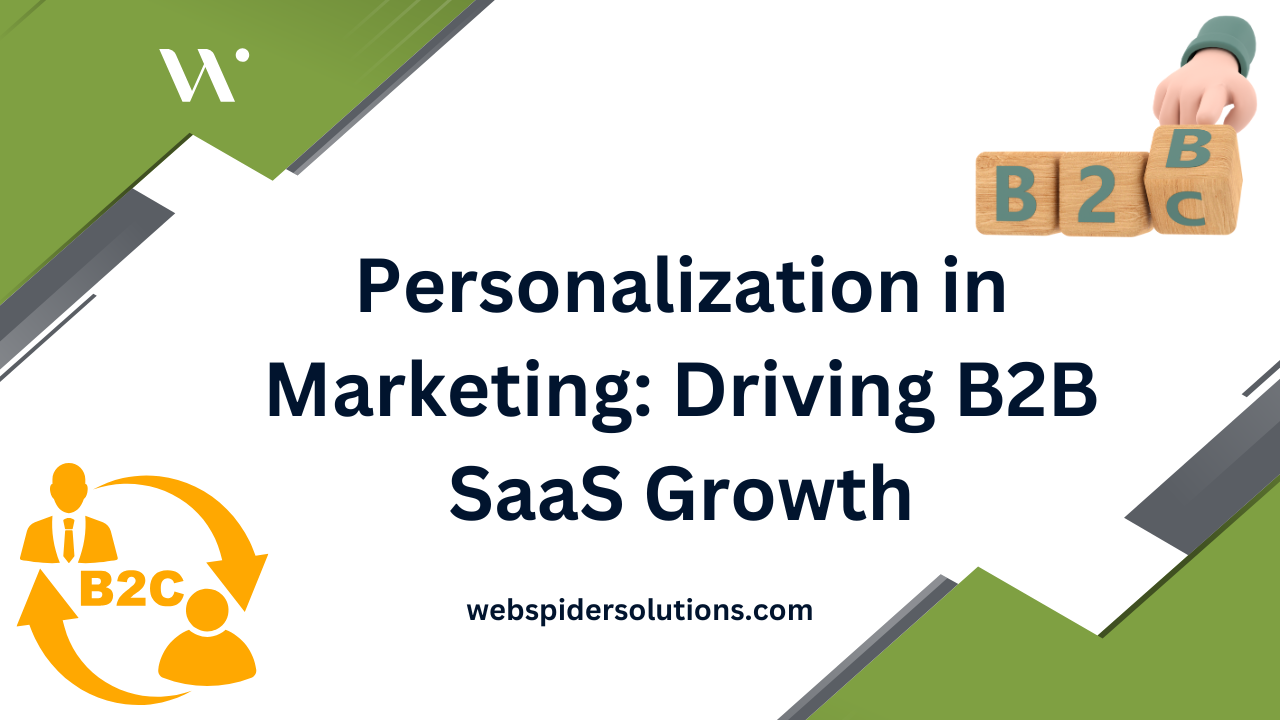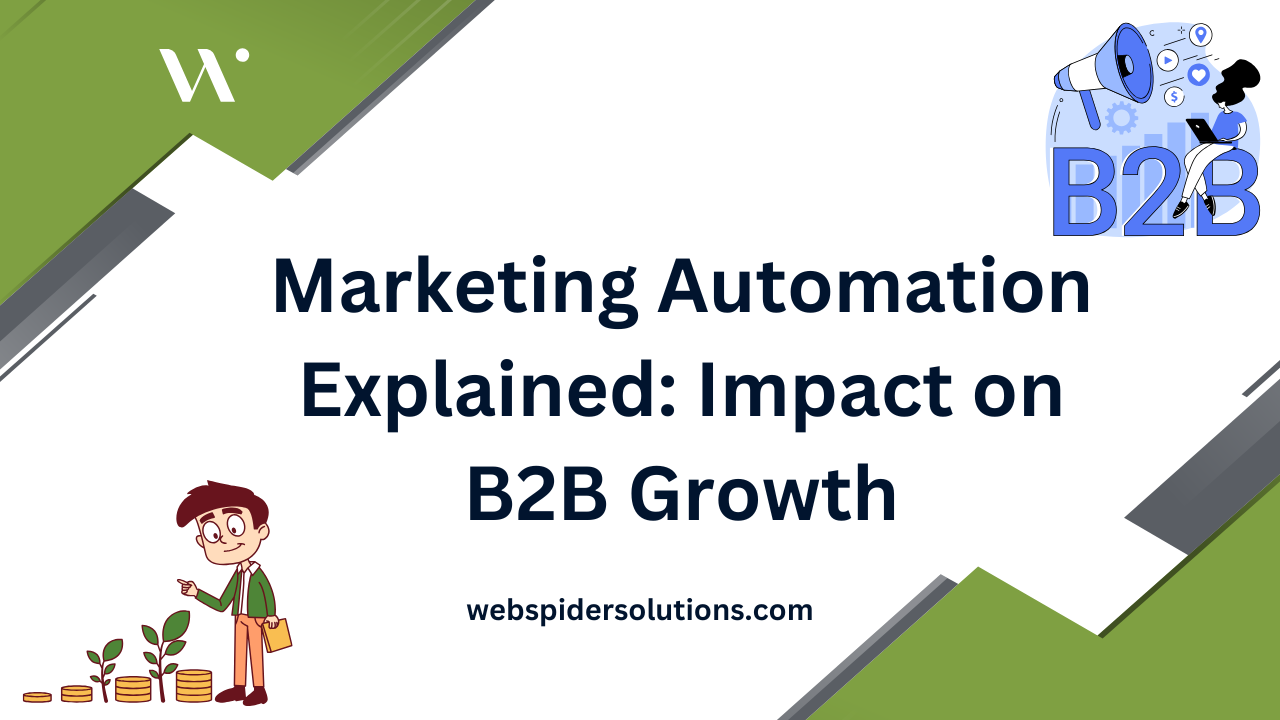Did you know that global digital advertising spending is expected to surpass $870 billion by 2027? The rapid shift from traditional to online media continues to reshape how brands connect with people every day. With countless platforms and tools available, understanding digital advertising is now vital for anyone who wants to reach the right audience and make smart marketing decisions that actually drive results.
Table of Contents
- Defining Digital Advertising And Its Core Concepts
- Main Types Of Digital Advertising Channels
- How Digital Advertising Campaigns Work
- Targeting Audiences And Setting Budgets
- Measuring Performance And Calculating Roi
- Common Pitfalls And How To Avoid Them
Key Takeaways
| Point | Details |
|---|---|
| Digital Advertising Evolution | Digital advertising revolutionizes traditional marketing through advanced targeting, real-time analytics, and personalized engagement. |
| Types of Channels | Businesses can utilize various digital advertising channels like SEM, social media, and email marketing, each offering unique strengths and strategies. |
| Strategic Budgeting | Effective digital advertising requires precise budget allocation and performance monitoring to maximize impact and adaptability. |
| Performance Measurement | Utilizing KPIs such as CTR and ROI is essential for assessing campaign effectiveness and guiding data-driven marketing decisions. |
Defining Digital Advertising and Its Core Concepts
Digital advertising represents a strategic approach to promoting products, services, and brands through digital channels and online platforms. According to research from ijfmr, digital advertising has dramatically transformed traditional marketing methodologies by leveraging technology and internet-based communication networks.
At its core, digital advertising encompasses targeted promotional activities conducted across multiple online platforms such as websites, social media, search engines, mobile applications, and email networks. Digital marketing strategies differ fundamentally from traditional advertising by offering unprecedented levels of audience segmentation, real-time performance tracking, and highly personalized engagement opportunities. As explored by science, the evolution of digital marketing represents a significant paradigm shift in how businesses communicate and interact with potential customers.
Key characteristics of digital advertising include:
- Precise audience targeting capabilities
- Measurable and trackable campaign performance
- Cost-effective compared to traditional advertising methods
- Dynamic and adaptable campaign strategies
- Ability to generate immediate engagement and feedback
Understanding how digital advertising works requires recognizing its multifaceted nature. Unlike traditional advertising’s broad approach, digital platforms enable marketers to pinpoint specific demographic groups, interests, behaviors, and geographic locations. This precision allows businesses to craft highly tailored messages that resonate directly with their ideal customer base, maximizing return on investment and minimizing wasted advertising expenditure.

Main Types of Digital Advertising Channels
Digital advertising encompasses diverse channels that enable businesses to reach and engage potential customers across multiple online platforms. According to research from jetir, there are six primary types of digital advertising channels that businesses can leverage to maximize their marketing effectiveness.
Search Engine Marketing (SEM) represents a critical digital advertising channel where businesses place targeted advertisements within search engine results. As highlighted by jatit, SEM allows companies to appear prominently when potential customers search for specific keywords related to their products or services. This method provides immediate visibility and enables precise audience targeting based on search intent.
The primary digital advertising channels include:
Here’s a comparison of the main digital advertising channels and their key features:
| Channel | Ad Format | Strengths | Typical Platforms |
|---|---|---|---|
| Search Advertising | Text ads in search results | High intent targeting Quick visibility |
Google Ads Bing Ads |
| Display Advertising | Banner & visual ads on websites | Broad reach Brand awareness |
Google Display Network Websites |
| Social Media Advertising | Sponsored posts & stories | Granular audience targeting High engagement |
Facebook |
| Video Advertising | Video clips before/during content | Strong storytelling Visual impact |
YouTube Streaming platforms |
| Native Advertising | Sponsored content in website style | Seamless experience High relevance |
News sites Social feeds |
| Email Marketing | Direct messages to inboxes | Personalization Retention |
Gmail Outlook Mailchimp |
- Search Advertising: Text-based ads appearing in search engine results
- Display Advertising: Visual banner ads across websites and platforms
- Social Media Advertising: Targeted promotions on platforms like Facebook, Instagram, LinkedIn
- Video Advertising: Promotional content on platforms like YouTube and streaming services
- Native Advertising: Sponsored content that matches the look and feel of surrounding media
- Email Marketing: Targeted promotional messages sent directly to subscriber inboxes
Each digital advertising channel offers unique advantages and requires specific strategies for optimal performance. Explore our comprehensive guide on types of online advertising to understand how these channels can be strategically combined to create a robust digital marketing approach. Businesses must carefully select and integrate these channels based on their target audience, marketing objectives, and available resources to maximize their digital advertising ROI.
How Digital Advertising Campaigns Work
Digital advertising campaigns operate through a complex ecosystem of interconnected technologies and strategic interactions. According to research from arxiv, these campaigns involve intricate relationships between advertisers, online publishers, ad exchanges, and web users, creating a dynamic marketplace for targeted digital promotions.
Real-Time Bidding (RTB) represents a critical mechanism in modern digital advertising campaigns. As detailed by arxiv, RTB enables instantaneous ad placement through sophisticated algorithmic processes that evaluate and bid on individual ad impressions milliseconds before a web page loads. This technology allows advertisers to target specific audience segments with unprecedented precision and efficiency.
The typical digital advertising campaign workflow includes these key stages:
- Campaign Planning: Defining target audience, objectives, and budget
- Audience Segmentation: Identifying precise demographic and behavioral characteristics
- Channel Selection: Choosing appropriate digital platforms for ad placement
- Creative Development: Designing compelling ad content
- Targeting Setup: Configuring demographic, geographic, and interest-based filters
- Performance Tracking: Monitoring metrics like click-through rates, conversions, and ROI
Learn more about how paid advertising works with our comprehensive guide to understand the intricate mechanisms behind successful digital marketing strategies. By leveraging advanced targeting technologies and data-driven insights, businesses can create highly effective advertising campaigns that reach the right audience at the right moment, maximizing their marketing investments and driving meaningful engagement.
Targeting Audiences and Setting Budgets
Effective digital advertising requires a strategic approach to audience targeting and budget allocation. According to research from arxiv, businesses must develop sophisticated methods for distributing finite marketing resources across various advertising channels to maximize their potential impact and influence.
Audience Targeting represents a critical component of successful digital advertising campaigns. Modern targeting strategies go beyond basic demographic information, leveraging advanced data analytics to create highly granular audience segments. These segments are defined by complex combinations of characteristics including:
- Behavioral patterns
- Online browsing history
- Purchase intentions
- Geographic location
- Professional background
- Specific interests and preferences
Budget Allocation Strategies require careful mathematical precision and strategic thinking. Research from arxiv highlights the importance of developing adaptive budget models that can respond dynamically to market conditions and campaign performance. Successful budget management involves:
- Setting clear campaign objectives
- Establishing realistic spending limits
- Monitoring real-time performance metrics
- Implementing rapid reallocation of resources
- Conducting continuous performance analysis
Explore our display advertising services to understand how precise audience targeting and strategic budget management can transform your digital marketing approach. By combining data-driven insights with flexible spending strategies, businesses can create more effective advertising campaigns that deliver measurable results and optimize their marketing investments.

Measuring Performance and Calculating ROI
Measuring digital advertising performance requires a comprehensive approach that goes beyond surface-level metrics. According to research from arxiv, effective performance measurement involves understanding the intricate interactions between advertisers, online publishers, and digital platforms to generate meaningful insights.
Key Performance Indicators (KPIs) are critical for evaluating digital advertising effectiveness. These metrics provide quantifiable evidence of campaign success across multiple dimensions:
- Click-Through Rate (CTR): Percentage of users who click on an advertisement
- Conversion Rate: Proportion of users who complete a desired action
- Cost Per Acquisition (CPA): Total cost of acquiring a single customer
- Return on Ad Spend (ROAS): Revenue generated per advertising dollar invested
- Engagement Rate: Level of user interaction with advertising content
- Impressions: Total number of times an ad is displayed
Calculating Return on Investment (ROI) requires a sophisticated analytical approach. As highlighted by arxiv, modern digital advertising platforms leverage advanced algorithms and real-time bidding technologies to provide granular performance tracking. The fundamental ROI calculation involves comparing total revenue generated against total advertising expenditure, with more advanced models incorporating additional variables like customer lifetime value and indirect marketing benefits.
Explore our comprehensive guide on measuring marketing ROI to gain deeper insights into transforming raw performance data into actionable business intelligence. By developing a nuanced understanding of these metrics, businesses can optimize their digital advertising strategies, allocate resources more effectively, and drive sustainable growth through data-driven decision-making.
Common Pitfalls and How to Avoid Them
Digital advertising campaigns are fraught with potential challenges that can undermine marketing effectiveness and drain financial resources. According to research from arxiv, understanding and anticipating these pitfalls is crucial for developing robust advertising strategies that deliver meaningful results.
Budget Misallocation represents one of the most significant risks in digital advertising. Research from arxiv highlights the critical importance of strategic resource distribution. Common budget-related pitfalls include:
- Overinvesting in underperforming channels
- Failing to diversify advertising platforms
- Neglecting performance tracking and real-time adjustments
- Ignoring audience segmentation nuances
- Applying uniform strategies across different market segments
Technical and strategic pitfalls that businesses must carefully navigate include:
- Poorly Defined Target Audiences: Creating generic, unfocused advertising campaigns
- Ineffective Tracking: Not implementing comprehensive analytics
- Inconsistent Messaging: Lack of coherence across different advertising channels
- Neglecting Mobile Optimization: Failing to adapt content for mobile platforms
- Ignoring Data Privacy: Overlooking crucial user consent and data protection regulations
Explore our comprehensive guide on understanding paid advertising to develop a more nuanced approach to digital marketing challenges. By proactively identifying and addressing these common pitfalls, businesses can create more resilient, effective advertising strategies that maximize return on investment and minimize potential risks.
Unlock the Full Potential of Your Digital Advertising Strategy
Understanding strategies, types, and ROI in digital advertising is just the first step to overcoming challenges like precise audience targeting, budget allocation, and measurable campaign performance. If you’ve felt overwhelmed by managing multiple ad channels or unsure how to calculate your marketing ROI effectively, you are not alone. The need for tailored campaigns that maximize every advertising dollar and avoid common pitfalls is critical for sustaining growth and beating competitors.
At Web Spider Solutions, we specialize in crafting data-driven, customized digital marketing campaigns designed to solve exactly these problems. Whether you need expert help with paid advertising to drive immediate visibility or strategic planning for long-term success, our team understands how to translate complex digital advertising concepts into actionable, results-focused solutions. Discover powerful approaches to Paid Advertising that increase targeted leads or explore our expertise in B2B Marketing for tailored outreach.
Ready to transform your digital advertising results now Explore your options with us and take the first step toward optimized campaigns and measurable ROI at Web Spider Solutions. Connect with our experts today and turn strategy into success.
Frequently Asked Questions
What is digital advertising?
Digital advertising refers to the strategic promotion of products, services, and brands through various digital channels and platforms, utilizing technology and internet communication to reach targeted audiences.
How do digital advertising campaigns work?
Digital advertising campaigns operate through a series of stages including campaign planning, audience segmentation, channel selection, creative development, targeting setup, and performance tracking—all facilitated by real-time bidding and advanced targeting technologies.
What are the main types of digital advertising channels?
The main types of digital advertising channels include Search Advertising, Display Advertising, Social Media Advertising, Video Advertising, Native Advertising, and Email Marketing, each offering unique formats and strengths.
How can businesses measure the effectiveness of their digital advertising?
Businesses can measure the effectiveness of digital advertising through key performance indicators (KPIs) such as Click-Through Rate (CTR), Conversion Rate, Cost Per Acquisition (CPA), Return on Ad Spend (ROAS), Engagement Rate, and Impressions to evaluate the success of their campaigns.
Recommended











